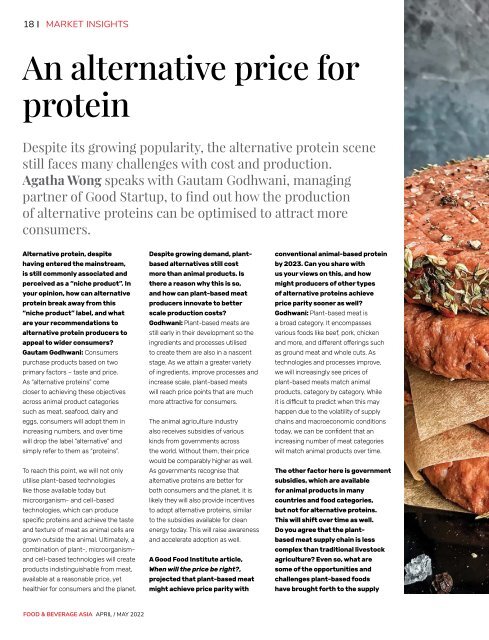Food & Beverage Asia April/May 2022
Food & Beverage Asia (FBA) is the leading source of food and beverage news in Asia since 2002. FBA delivers a comprehensive view of the food and beverage landscape, spanning across the latest health and nutrition trends and industry innovations in ingredients, recipe formulations, food science, sustainability, packaging, and automation, as well as advancements in agri and food-tech.
Food & Beverage Asia (FBA) is the leading source of food and beverage news in Asia since 2002. FBA delivers a comprehensive view of the food and beverage landscape, spanning across the latest health and nutrition trends and industry innovations in ingredients, recipe formulations, food science, sustainability, packaging, and automation, as well as advancements in agri and food-tech.
You also want an ePaper? Increase the reach of your titles
YUMPU automatically turns print PDFs into web optimized ePapers that Google loves.
18<br />
MARKET INSIGHTS<br />
An alternative price for<br />
protein<br />
Despite its growing popularity, the alternative protein scene<br />
still faces many challenges with cost and production.<br />
Agatha Wong speaks with Gautam Godhwani, managing<br />
partner of Good Startup, to find out how the production<br />
of alternative proteins can be optimised to attract more<br />
consumers.<br />
Alternative protein, despite<br />
having entered the mainstream,<br />
is still commonly associated and<br />
perceived as a “niche product”. In<br />
your opinion, how can alternative<br />
protein break away from this<br />
“niche product” label, and what<br />
are your recommendations to<br />
alternative protein producers to<br />
appeal to wider consumers?<br />
Gautam Godhwani: Consumers<br />
purchase products based on two<br />
primary factors – taste and price.<br />
As “alternative proteins” come<br />
closer to achieving these objectives<br />
across animal product categories<br />
such as meat, seafood, dairy and<br />
eggs, consumers will adopt them in<br />
increasing numbers, and over time<br />
will drop the label “alternative” and<br />
simply refer to them as “proteins”.<br />
To reach this point, we will not only<br />
utilise plant-based technologies<br />
like those available today but<br />
microorganism- and cell-based<br />
technologies, which can produce<br />
specific proteins and achieve the taste<br />
and texture of meat as animal cells are<br />
grown outside the animal. Ultimately, a<br />
combination of plant-, microorganismand<br />
cell-based technologies will create<br />
products indistinguishable from meat,<br />
available at a reasonable price, yet<br />
healthier for consumers and the planet.<br />
Despite growing demand, plantbased<br />
alternatives still cost<br />
more than animal products. Is<br />
there a reason why this is so,<br />
and how can plant-based meat<br />
producers innovate to better<br />
scale production costs?<br />
Godhwani: Plant-based meats are<br />
still early in their development so the<br />
ingredients and processes utilised<br />
to create them are also in a nascent<br />
stage. As we attain a greater variety<br />
of ingredients, improve processes and<br />
increase scale, plant-based meats<br />
will reach price points that are much<br />
more attractive for consumers.<br />
The animal agriculture industry<br />
also receives subsidies of various<br />
kinds from governments across<br />
the world. Without them, their price<br />
would be comparably higher as well.<br />
As governments recognise that<br />
alternative proteins are better for<br />
both consumers and the planet, it is<br />
likely they will also provide incentives<br />
to adopt alternative proteins, similar<br />
to the subsidies available for clean<br />
energy today. This will raise awareness<br />
and accelerate adoption as well.<br />
A Good <strong>Food</strong> Institute article,<br />
When will the price be right?,<br />
projected that plant-based meat<br />
might achieve price parity with<br />
conventional animal-based protein<br />
by 2023. Can you share with<br />
us your views on this, and how<br />
might producers of other types<br />
of alternative proteins achieve<br />
price parity sooner as well?<br />
Godhwani: Plant-based meat is<br />
a broad category. It encompasses<br />
various foods like beef, pork, chicken<br />
and more, and different offerings such<br />
as ground meat and whole cuts. As<br />
technologies and processes improve,<br />
we will increasingly see prices of<br />
plant-based meats match animal<br />
products, category by category. While<br />
it is difficult to predict when this may<br />
happen due to the volatility of supply<br />
chains and macroeconomic conditions<br />
today, we can be confident that an<br />
increasing number of meat categories<br />
will match animal products over time.<br />
The other factor here is government<br />
subsidies, which are available<br />
for animal products in many<br />
countries and food categories,<br />
but not for alternative proteins.<br />
This will shift over time as well.<br />
Do you agree that the plantbased<br />
meat supply chain is less<br />
complex than traditional livestock<br />
agriculture? Even so, what are<br />
some of the opportunities and<br />
challenges plant-based foods<br />
have brought forth to the supply<br />
FOOD & BEVERAGE ASIA APRIL / MAY <strong>2022</strong>


















